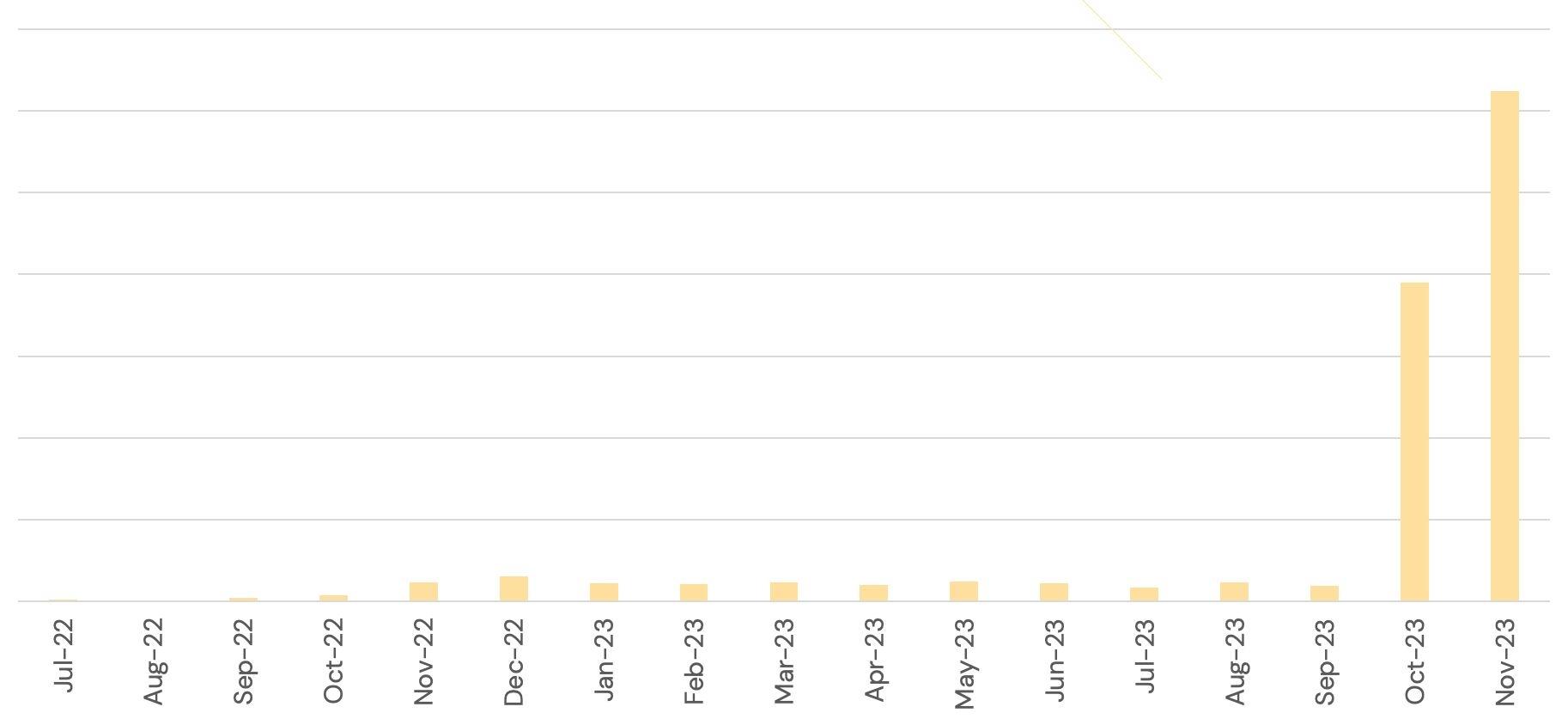In this article:
- 2023 recap: The year of mobile messaging
- 4 Q4 lessons that will help boost your messaging strategy in 2024
- Conclusion: Omnichannel is the way to go in 2024
In 2023, brands took mobile messaging to center stage, using channels like SMS, RCS, and WhatsApp for both one-way messages and conversational marketing. This move coincided with increased online spending – in the U.S. alone, online sales in 2023 were up 7.5% on Black Friday and 9.6% on Cyber Monday from 2022. We thought that was a pretty big deal!
To gain deeper insights, we dug into results from our 2023 consumer survey on messaging expectations around the holidays to see how they stacked up against sending data from Black Friday and Cyber Monday (BFCM) 2023.
We hope these results may help inform and reshape your marketing strategy in 2024, setting the stage for a year where every message isn’t just sent, but it resonates!
2023 recap: The year of mobile messaging
Your customers want to hear from you, and mobile messaging is a powerful way for you to deliver what they want. With a 98% open rate, SMS is ideal for time-sensitive campaigns like Black Friday or Cyber Monday flash sales, and other conversational messaging channels like Rich Communication Services (RCS) can help build trust and transform your marketing messages into dynamic, engaging conversations.
However, just sending messages doesn’t cut it in this day and age. Understanding customer preferences for communications is key to deliver a strong customer experience, regardless of your chosen channels.
So, in 2023 we surveyed over 2,000 people about how they want to hear from brands during BFCM. Here’s what we found:
-
69.5% of people prefer email, with social media (22%) and text messaging (19%) as the second most preferred forms of communication.
-
57% of people want communications well ahead of Black Friday, with 36% of people wanting messages “as soon as possible.”
-
44.9% of those who wanting transactional messages from brands prefer them on one or more mobile messaging channels, rising to 59.1% for people under 30.

Next, we looked at how brands delivered during BFCM, revealing trends for 2024: The continued significance of SMS, the rising popularity of RCS, the growth of conversational channels, and the critical importance of choosing the right communication channels.
4 Q4 lessons that will help boost your messaging strategy in 2024
Following Black Friday and Cyber Monday 2023, where we initially anticipated high messaging volumes due to significant growth in 2022, we dug into the data for actionable strategies for 2024.
If you’re aiming to enhance your campaigns or refine your strategies in the upcoming year or if your Q4 fell short this year, these insights can provide valuable lessons. Consider this a guide to ensure effective connections with your audience in 2024.
Lesson 1: Spike in BFCM messaging underscores the significance of SMS during peak periods
For many brands, SMS is a key part of their Black Friday and Cyber Monday messaging strategy for promotions as well as transactional messages. This aligns with customer expectations, with 80% of consumers in our survey saying transactional messages are important, particularly during the holiday season.
Additionally, 35.6% of people expressed interest in receiving promotional messages via one or more mobile messaging channel.
But are these consumer expectations aligned with actual sending volumes during the holidays?
At Sinch, we processed more than four billion SMS messages during Cyber Week and more than 800 million SMS messages on Black Friday. The takeaway here is that brands are honing their skills by giving customers what they want.
Additionally, we saw significant SMS volume sends in markets like Mexico, Canada, Australia, the UK, France, Sweden, and the United States during Cyber Week.
This is due to businesses in these markets following communication trends and meeting customers’ growing preferences for personalized, timely communications, indicating a significant opportunity for businesses that operate in these regions to capitalize on the momentum.
SMS will remain crucial in 2024
So, what can enterprises learn from this data? In 2024, we expect it’ll be all about recognizing the pivotal role of SMS during BFCM and beyond. Fine-tune your strategies, especially in markets experiencing growth, and make sure your messaging aligns with customer expectations.
Lesson 2: RCS is experiencing exponential growth
RCS, known for its engaging capabilities that help brands create rich, branded, immersive experiences on Android, is building traction, and Apple’s recent announcement that they’ll start supporting this channel in 2024 only proves that.
In November 2023, brands sent 25,000x more RCS messages than they did in February 2022. No, that’s not a typo – that’s a 25,000-fold growth from earlier in the year when RCS was still gaining momentum.

Graph shows rising RCS traffic over 17 months up to November 2023, pointing to a growing adoption of RCS by brands to communicate with customers.
In fact, in Q4 2023, Sinch sent the largest number of RCS business messages in France than any other provider, sending four times as many RCS messages in 2023 than in 2022. This underscores the rapid expansion of RCS messaging in key markets, and we expect more rapid growth in 2024.
In 2023, we saw many brands use RCS when possible, and use SMS as a fallback channel for recipients without RCS support. Looking ahead, a pivotal moment looms with Apple supporting RCS in 2024. While details are still unclear, this announcement will likely mean that many brands adopt RCS in 2024 because they'll be able to build more engaging content and build trust on all the devices their audiences use.
RCS will redefine customer engagement
What can you learn from RCS’ exponential growth? Start embracing branded messages as part of your omnichannel strategy now so you’re ready to test, iterate, and make the most of RCS after Apple starts implementing it. Establishing RCS now positions your brand to stand out, ensuring you’re at the forefront when more users have access to its dynamic capabilities.
Lesson 3: Your customers want to talk to you
As we dig into BFCM 2023, a standout lesson for 2024 is the significant impact of conversational marketing. With channels like WhatsApp and RCS being inherently more conversational, the brands that are using them are getting a step ahead. These channels provide a great add-on to channels like email during busy shopping periods.
And here’s why: In Europe, during the BFCM period, WhatsApp messages boasted a read rate of more than 84% and RCS messages had a 71.6% read rate. Clearly, customers are receptive to receiving messages on conversational channels during the holidays. And when used as part of your omnichannel strategy, these channels can help your brand shine among cluttered email inboxes, ensuring a more direct connection with your audience.
Embrace conversational channels
So, what’s the lesson for 2024? Start adopting conversational channels like WhatsApp and RCS as part of your marketing strategy in 2024. Strategically incorporating these channels to your omnichannel messaging mix and using these channels’ features like rich content and branded sender capabilities will be a powerful first step towards building genuine relationships with your customers.
Lesson 4: Customers prefer omnichannel communications
Email remains peoples’ favorite channel to receive promotional messages from brands. However, with people responding so well to other messaging channels and the landscape changing so quickly with RCS, and it’s clear that there are other lessons to be learned for enterprises gearing up for 2024.
Let’s start by highlighting the growth of email during BFCM, where in 2023, there was a 15% surge in emails sent on Black Friday and a 17% increase in emails sent on Cyber Monday compared to 2022. In fact, two weeks before the week of Black Friday, when the biggest surge happened, volumes were up 34% from last year.
Engagement was also strong in the inbox, with emails sent on Black Friday had a 13% click-through-rate (CTR), followed closely by an 11% CTR on Cyber Monday. Considering the huge volume of emails that are sent during this period, these figures are quite remarkable.
Clearly, email is an incredibly important channel. But the sheer volume of emails people receive during this time emphasizes the importance of differentiating your communication strategies, especially with the holiday season starting earlier every year.
In fact, our consumer survey found that 56.7% of people want to hear from your brand well in advance of Black Friday, and 35.5% say they want to get these communications as soon as possible.
Tailor messaging across channels
Our fourth lesson is to use diverse channels to communicate with your customers.
As a business or enterprise, you should be tailoring your messaging to align with individual customer preferences, and using different combinations of email, SMS, and mobile messaging to share updates. That way, you’re not overwhelming inboxes, but instead creating a message strategy that resonates with each individual member of your audience.
Conclusion: Omnichannel is the way to go in 2024
Messaging volumes and engagement metrics during Black Friday and Cyber Monday 2023 serve as valuable data points to indicate changes in mobile messaging over the past year. When we compare these statistics with what customers said they wanted to receive from brands around the holidays, it’s evident that brands aligning their messaging strategies with those preferences will get ahead.
As mobile messaging continues to evolve, our key takeaway is this: Success lies in using the collective power of diverse channels. It’s about using each channel strategically, with SMS for its immediacy, RCS for its engaging capabilities, email for its efficiency, and conversational channels for creating genuine connections with your audience.
In the new year, staying ahead will mean staying agile – that means keeping a keen eye on emerging trends, embracing new technologies, and being ready to adapt quickly. This will help you keep up with customer expectations while also ensuring your messaging strategy remains innovative and efficient.
Happy 2024!



